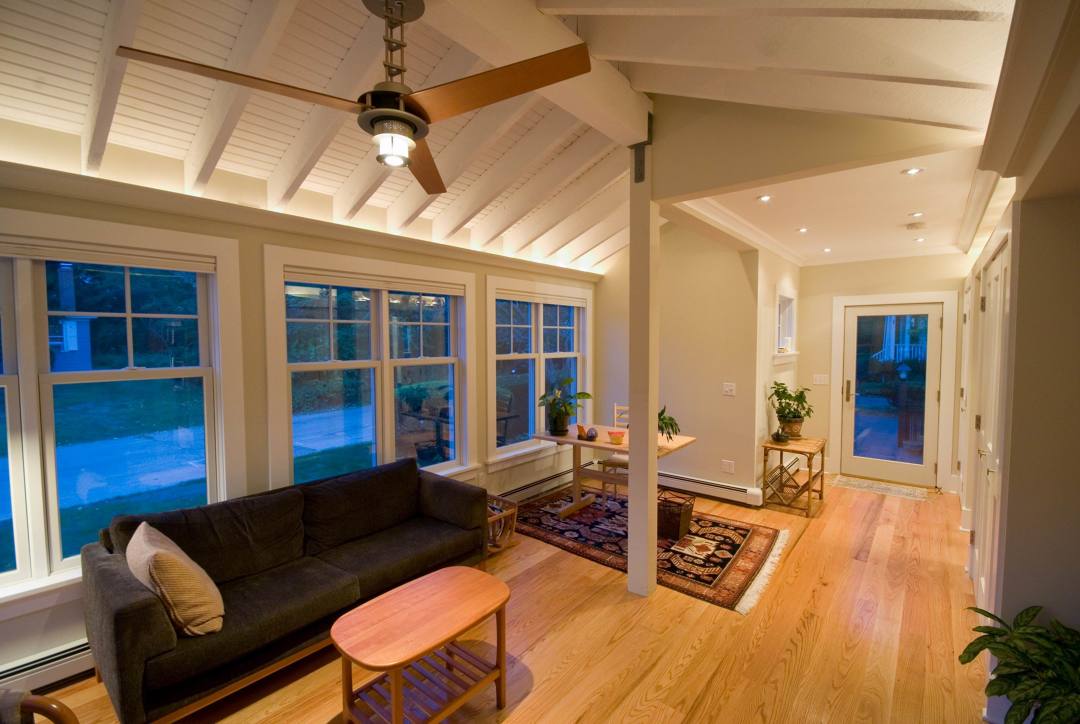
Image Credit: Joseph Cracco
Image Credit: Joseph Cracco This old porch was dismantled to make room for the more spacious, energy-efficient sunroom.
Image Credit: Joseph Cracco Insulated concrete forms (ICFs) are an efficient way to build and insulate a foundation — especially for small additions.
Image Credit: Joseph Cracco Rigid polyisocyanurate foam insulation is on the outside of the exposed sunroom ceiling. A vented roof assembly sits above the foam.
Image Credit: Joseph Cracco Rigid XPS foam insulation was installed outside of the roof sheathing to allow for the exposed rafters and to create a good thermal break. Fiberglass in the walls, XPS foam in the headers, and and ICF foundation round out this tight envelope.
Image Credit: Rob Wotzak
The goal was to raise sustainability but not costs
The owners of this traditional Rhode Island home wanted to better express their eclectic taste when upgrading their cramped porch to a sunroom addition. A better view of the river was a side benefit.
Although the plans didn’t specifically focus on green building, Joseph Cracco, of Modern Yankee Builders, challenged himself to raise the project’s level of sustainability without raising the cost. The result is a bright and airy family room, an expanded second-floor office, and a new basement that performs better than the family had imagined possible.
Low-impact is multifaceted
You could say that the motto of Joe’s team is to tread lightly. Almost 19 tons of concrete were reclaimed by grinding the old foundation into gravel for road beds. The rest of the construction debris was hauled to New England Recycling, in Taunton, Massachusetts, where typically 82 percent of waste is separated for reuse.
After the original porch was deconstructed, the new work shared as much of the original footprint as possible. Site disturbance was kept to a minimum — existing bushes were temporarily moved, then replanted; turf was quickly re-established in some areas and replaced with planting beds in others; the new gas line was even tunneled rather than trenched in the front yard.
Sustainability extends to efficient operation
The addition doesn’t just tread lightly, it uses fewer sticks. The structure is built with advanced-framing techniques on top of a thoroughly waterproofed Insulated Concrete Form (ICF) basement. To allow for the decorative rafters and sheathing inside the new space, and to create a good thermal break, XPS insulation was installed outside of the roof deck.
The whole exterior got a well-sealed drainage plane and air barrier. After that, a self-adhesive water shield, sleepers, CDX, and 30-year asphalt shingles created a fully vented roof surface while hard-wearing FSC-certified cedar shingles wrapped the walls. Joe’s dedication and attention to detail paid off. The homeowners got a place they can be proud of for years to come, with little added burden on the budget or the environment.
Weekly Newsletter
Get building science and energy efficiency advice, plus special offers, in your inbox.
Lessons Learned
Modern Yankee's trek to the 2007 International Builders' Show left its principals pleasantly surprised at how sustainable their standard practices already were. They still logged plenty of hours of research for this addition. This not only made the results better than the clients had asked for, but further integrated green concepts into Modern Yankee's "business as usual," proving that quality, affordability, and sustainability can all go hand in hand.
General Specs and Team
| Location: | Barrington, RI |
|---|---|
| Living Space: | 635 |
| Cost: | 280 |
Builder: Joseph C. Cracco, CGR, CAPS, CGP, Modern Yankee Builders
Architect/designer: Katrin Boening and Sean Solley, Solleydesign
Construction
Foundation: ICF basement (R-22)
Walls: 2x6, 24in. o.c.; XPS sandwiched within headers (R-10), fiberglass batts (R-19)
Windows: double-glazed, low-e (R-2.9, SHGC - .29)
Roof: 2x6 T&G roof decking over exposed rafters; 4-in. polyisocyanurate foam board with taped seams(R-24); 2x sleepers and 5/8-in. plywood sheathing over rigid foam
Energy
- Bank of windows provides ample daylighting and natural cooling
- ICF foundation
- Continuous XPS installed above roof decking (virtually no thermal bridging)
- Rigid foam insulation built into window and door headers
- Electronic programmable thermostat
Energy Specs
Heating/cooling: hydronic baseboard tied into existing loops on upper floor; new zone off existing furnace with programmable thermostat at main floor; no heat at basement; variable-speed air handler, condenser (13 SEER) in existing top floor
Water Efficiency
- Reduced lawn area (less irrigation demand)
Indoor Air Quality
- Temporary filters covered HVAC returns during construction
- MERV 11 filters fitted to AC returns post-construction
- All materials kept dry during construction (just-in-time delivery, tarps above and below any stored lumber)
- Formaldehyde-free Advantech OSB subfloor
Green Materials and Resource Efficiency
- Ensured durability through meticulous detailing of drainage and ventilation
- FSC-certified cedar shingle siding
- Demolished foundation ground into gravel for reuse
- Other construction debris recycled
- Optimal value engineering (OVE)











0 Comments
Log in or create an account to post a comment.
Sign up Log in